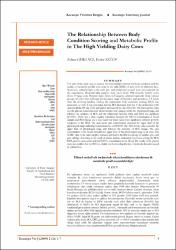The Relationship Between Body Condition Scoring and Metabolic Profile in the High Yielding Dairy Cows
Özet
The aim of the study was to analyse the relationship between the body condition and the
results of metabolic profile tests done in the milk (DIM) of dairy cows in different days.
Moreover, critical points in the early pre- and postpartum period were also analysed. In
the experiment, blood and urine samples were taken from 1984 clinically healthy cows
(from 49 large scale Holstein dairy farms in Hungary), selected randomly from various
groups of cows with different physiological stage of lactation and gestation, 3-5 hours
after the morning feeding. During the experiment body condition scoring (BCS) was
measured, as well. It was concluded, that the BCS decreased from the 1st day of lactation (3.48)
onwards till the 44th day (2.65) and slightly increased till the day 218 (2.89). The haemoglobin value
and the glucose concentration in blood samples were ranging within the physiological range and
followed the tendency of BCS and the relationship between them and DIM was significant
(p<0.001). There was a close negative correlation between the NEFA concentration in blood
samples and BCS change and it was found that these values were significantly different (p<0.01)
compared to the DIM. The aceto-acetic acid concentration exceeded the upper limit of the
physiological range indicating hyperketonaemia at DIM 18. The AST activity value exceeded the
upper limit of physiological range and followed the tendency of BCS change. The urea
concentration in the blood exceeded the upper limit of the physiological range in all cows. The
NABE value in the urine samples indicated acid load in the first two groups of samples (pre-, and
post calving). According to the result of cluster analysis, relationship was found among the BCS,
DIM, glucose, aceto-acetic acid and NEFA concentration in the blood. The results of the present
study also confirm that the BCS is a reliable tool for revealing the risk of metabolic disorders caused
by malnutrition. Bu çalışmanın amacı süt sığırlarında farklı günlerde sütte yapılan metabolik analiz
sonuçları ile vücut kondüsyonu arasındaki ilişkiyi incelemelti. Ayrıca erken pre- ve
postpartum periyotlardaki kiritik noktalar değerlendirildi. Araştırmada sabah
yemlemeden 3-5 sonra rastgele seçilen farklı gruplarda fizyolojik laktasyon ve gestasyon
safhalarında olan klinik bakımdan sağlıklı olan 1984 adet inekten (Macaristan’da 49
büyük Holştayn süt çiftliklerinden) kan ve sidik örnekleri alında. Çalışma süresince vücut
kondüsyon skoruda (BCS) ölçüldü. Sonuç olarak, BCS’u laktasyonun 1. gününden (3.48)
44. gününe (2.65) kadar azalma eğilimi ve 218. gününe (2.89) kadar hafif artış gösterdi.
Kandaki hemoglobin değeri ve glukoz konsantrasyonu fizyolojik sınırlar içerisinde seyir
etti ve BCS ile bunlar ve DIM arasında takib eden ilişki anlamlıydı (P<0.001). kan
örneklerinde ki NEFA ile BCS değişiminde negatif bir ilişki vardı ve bu değerler DIM’le
karşılaştırıldığında anlamlı derecede farklıydı (p<0.01). Asetoasetik asit konsantrasyonu üst fizyolojik
sınırları aştı buda DIM 18’de hiperketoneminin belirtisidir. AST üst fizyolojik sınırları aştı ve BCS
değişimine benzer eğilim gösterdi. Üre konsantrasyonu tüm sığırlarda üst fizyolojik değerleri aştı.
Sidikte NABE değeri ilk iki grupta asit yüklenmesini gösterdi (doğum öncesi ve sonrası). Cluster
analizine göre, kanda BCS, DIM, glukoz, asetoasetik asit ve NEFA konsantrasyonları arasında ilişki
olduğu tespit edildi. Bu çalışmanın bulguları ayrıca malnutrisyondan kaynaklanan metabolik
bozukluk risklerinin ortaya çıkarılmasında BCS’nin güvenilir bir araç olduğunu gösterdi.
Kaynak
Kocatepe Veteriner DergisiCilt
2Sayı
2Bağlantı
https://hdl.handle.net/11630/2208Koleksiyonlar
- Cilt 2 : Sayı 2 [11]



















